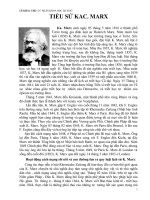SHARED V I S I O N
Bạn đang xem bản rút gọn của tài liệu. Xem và tải ngay bản đầy đủ của tài liệu tại đây (354.48 KB, 28 trang )
17. září 2004
190 ze 412
11
SHARED V I S I O N
A COMMON CARING
You may remember the movie
Spartacus,
an adaptation of the story of a
Roman gladiator/slave who led an army of slaves in an uprising in 71
B
.
C
.
1
They defeated the Roman legions twice, but were finally
conquered by the general Marcus Crassus after a long siege and
battle. In the movie, Crassus tells the thousand survivors in Sparta-
cus's army, "You have been slaves. You will be slaves again. But you
will be spared your rightful punishment of crucifixion by the mercy of
the Roman legions. All you need to do is turn over to me the slave
Spartacus, because we do not know him by sight."
After a long pause, Spartacus (played by Kirk Douglas) stands up
and says, "I am Spartacus." Then the man next to him stands up
and says, "I am Spartacus." The next man stands up and also says,
"No, I am Spartacus." Within a minute, everyone in the army is on his
feet.
It does not matter whether this story is apocryphal or not; it dem-
onstrates
a deep truth.
Each man, by standing up, chose death.
But
17. září 2004
191 ze 412
the
loyalty of Spartacus's army was not to Spartacus the man. Their'
loyalty
was to a shared vision which Spartacus
had
inspired—
the;
idea
that they could be free men. This vision was so compelling
that
j no man
could bear to give it up and return to slavery.
A shared vision is not an idea. It is not even an important idea
such as freedom. It is, rather, a force in people's hearts, a force off
impressive power. It may be inspired by an idea, but once it goes
further—if it is compelling enough to acquire the support of more;
than one person—then it is no longer an abstraction. It is palpable.
People begin to see it as if it exists. Few, if any, forces in human
affairs are as powerful as shared vision.
At its simplest level, a shared vision is the answer to the question,
"What do we want to create?" Just as personal visions are pictures or
images people carry in their heads and hearts, so too are shared
visions pictures that people throughout an organization carry. They
create a sense of commonality that permeates the organization and
gives coherence to diverse activities.
A vision is truly shared when you and I have a similar picture and are
committed to one another having it, not just to each of us, indi-
vidually, having it. When people truly share a vision they are con-
nected, bound together by a common aspiration. Personal visions
derive their power from an individual's deep caring for the vision.
Shared visions derive their power from a common caring. In fact, we
have to come to believe that one of the reasons people seek to build
shared visions is their desire to be connected in an important under-
taking.
Shared vision is vital for the learning organization because it pro-
vides the focus and energy for learning. While adaptive learning is
possible without vision, generative learning occurs only when people
are striving to accomplish something that matters deeply to them. In
fact, the whole idea of generative learning—"expanding your ability to
create"—will seem abstract and meaningless
until
people become
excited about some vision they truly want to accomplish.
Today, "vision" is a familiar concept in corporate leadership., But
when you look carefully you find that most "visions" are one person's
(or one group's) vision imposed on an organization. Such visions, at
best, command compliance—not commitment. A shared vision is a
vision that many people are truly committed to, because it reflects
their own personal vision.
17. září 2004
192 ze 412
WHY SHARED VISIONS
MATTER
It is impossible to imagine the accomplishments of building AT&T,
Ford, or Apple in the absence of shared vision. Theodore Vail had a
vision of universal telephone service that would take fifty years to
bring about. Henry Ford envisioned common people, not just the
wealthy, owning their own automobiles. Steven Jobs, Steve Woz-
niak, and their Apple cofounders saw the power of the computer to
empower people. It is equally impossible to imagine the rapid ascen-
dancy of Japanese firms such as Komatsu (which grew from one
third the size of Caterpillar to its equal in less than two decades),
Canon (which went from nothing to matching Xerox's global market
share in reprographics in the same time frame), or Honda had they
not all been guided by visions of global success.
2
What is most im-
portant is that these individuals' visions became genuinely shared
among people throughout all levels of their companies—focusing the
energies of thousands and creating a common identity among enor-
mously diverse people.
Many shared visions are extrinsic—that is, they focus on achieving
something relative to an outsider, such as a competitor. Pepsi's vision
is explicitly directed at beating Coca-Cola; Avis's vision at Hertz. Yet,
a goal limited to defeating an opponent is transitory. Once the vision
is achieved, it can easily migrate into a defensive posture of "protecting
what we have, of not losing our number-one position." Such defensive
goals rarely call forth the creativity and excitement of building
something new. A master in the martial arts is probably not focused
so much on "defeating all others" as on his own intrinsic inner
standards of "excellence." This does not mean that visions must be
either intrinsic
or
extrinsic. Both types of vision can coexist. But
reliance on a vision that is solely predicated on defeating an adversary
can weaken an organization long term.
Kazuo Inamori of Kyocera entreats employees "to look inward," to
discover their own internal standards. He argues that, while striving to
be number one in its field, a company can aim to be "better" than
others or "best" in its field. But his vision is that Kyocera should
always aim for "perfection" rather than just being "best." (Note
Inamori's application of the principle of creative tension— "it's not
what the vision is, but what it does . . .")
3
A shared vision, especially one that is intrinsic, uplifts people's
aspirations. Work becomes part of pursuing a larger purpose embod-
17. září 2004
193 ze 412
ied in the organizations' products or services—accelerating learning
through personal computers, bringing the world into communication
through universal telephone service, or promoting freedom of mov«j
ment through the personal automobile. The larger purpose can alsi be
embodied in the style, climate, and spirit of the organization. Mai de
Pree, retired CEO of the Herman Miller furniture company said his
vision for Herman Miller was "to be a gift to the human spirit! —by
which he meant not only Herman Miller's products, but itl people, its
atmosphere, and its larger commitment to productive an<S| aesthetic
work environments.
4
Visions are exhilarating. They create the spark, the excitemeiji that
lifts an organization out of the mundane. "No matter how prow
lematic the competition or our internal troubles," wrote John Scul
ley about Apple's renowned visionary product, "my spirnj
rebounded when I strolled into the Macintosh Building. We knew w«j
would soon bear witness to an event of historical proportions."
3
In a corporation, a shared vision changes people's relationship^
with the company. It is no longer "their company;" it becomes "oiffl
company." A shared vision is the first step in allowing people wh<|
mistrusted each other to begin to work together. It creates a common!
identity. In fact, an organization's shared sense of purpose, vision^ and
operating values establish the most basic level of commonality.; Late in
his career, the psychologist Abraham Maslow studied high-performing
teams. One of their most striking characteristics was shared vision
and purpose. Maslow observed that in exceptional' teams
the task was no longer separate from the self. . . but rather he
identified with this task so strongly that you couldn't define his
real self without including that task.
6
Shared visions compel courage so naturally that people don't even
realize the extent of their courage. Courage is simply doing whatever is
needed in pursuit of the vision. In 1961, John Kennedy articulated a
vision that had been emerging for many years among leaders within
America's space program: to have a man on the moon by the end of
the decade.
7
This led to countless acts of courage and daring. A
modern-day Spartacus story occurred in the mid-1960s at MIT's
Draper Laboratories. The lab was the lead contractor with NASA
for the inertial navigation and guidance system to guide the Apollo
astronauts to the moon. Several years into the project, the lab direc-
tors became convinced that their original design specifications were
17. září 2004
194 ze 412
wrong. This posed considerable potential embarrassment, since sev-
eral million dollars had already been spent. Instead of trying to jerry-rig
an expedient solution, they asked NASA to disband the project and
start over again. They risked not just their contract but their
reputation. But no other action was possible. Their entire reason for
being was embodied in one simple vision—having a man on the
moon by the end of the decade. They would do whatever it took to
realize that vision.
Apple Computer during the mid-1980s, when the entire small com-
puter industry rallied behind the IBM PC, persevered with its vision of
a computer which people could understand intuitively, a computer
which represented the freedom to think on one's own. Along the
way, Apple not only refused the "sure thing" opportunity to be a
leading PC "clone" manufacturer, but its leaders gave up an inno-
vation which they had pioneered: open architecture, where people
could add their own components. This did not fit with a computer
that was easy to use. Strategically, the change paid off in a company
profile and reputation which even the foremost "clone" makers,
such as Compaq, have never been able to equal. Apple's Macintosh
was not only easy to use, it became a new industry standard and
made having fun a priority in personal computing.
You cannot have a learning organization without shared vision.
Without a pull toward some goal which people truly want to achieve,
the forces in support of the status quo can be overwhelming. Vision
establishes an overarching goal. The loftiness of the target compels
new ways of thinking and acting. A shared vision also provides a
rudder to keep the learning process on course when stresses de-
velop. Learning can be difficult, even painful. With a shared vision, we
are more likely to expose our ways of thinking, give up deeply held
views, and recognize personal and organizational shortcomings. All that
trouble seems trivial compared with the importance of what we are
trying to create. As Robert Fritz puts it, "In the presence of greatness,
pettiness disappears." In the absence of a great dream, pettiness
prevails.
Shared vision fosters risk taking and experimentation. "When you are
immersed in a vision," says Herman Miller's president Ed Simon,
"You know what needs to be done. But you often don't know how
to do it^ You run an experiment because you think it's going to get
you there. Tt doesn't work. New input. New data. You change
direction and run another experiment. Everything is an experiment,
but there is no ambiguity at all. It's perfectly clear why
17. září 2004
195 ze 412
you are doing it. People aren't saying, 'Give me a guarantee that ifj will
work.' Everybody knows that there is no guarantee. But thi people
are committed nonetheless."
Lastly, shared vision addresses one of the primary puzzles thn
has thwarted efforts to develop systems thinking in management!
"How can a commitment to the long term be fostered?'' |
For years, systems thinkers have endeavored to persuade maai
agers that, unless they maintained a long-term focus, they will be in big
trouble. With great vigor we have proselytized the "better befell worse"
consequences of many interventions, and the "shifting thl burden"
dynamics that result from symptomatic fixes. Yet, I havil witnessed
few lasting shifts to longer term commitment and actionf Personally, I
have come to feel that our failure lies not in unpersua* siveness or lack
of sufficiently compelling evidence.
It may simptm not be possible to
convince human beings rationally to take a lonm term view.
People do not
focus on the long term because they
havq
to, but because they
want
to.
In every instance where one finds a long-term view actually oper^
ating in human affairs, there is a long-term vision at work. The cathel
dral builders of the Middle Ages labored a lifetime with the fruits o|
their labors still a hundred years in the future. The Japanese believd
building a great organization is like growing a tree; it takes twenty^
1
five
to fifty years. Parents of young children try to lay a foundatiott of
values and attitude that will serve an adult twenty years hence. Inj all of
these cases, people hold a vision that can be realized only oveif the long
term.
Strategic planning, which should be a bastion of long-term thinking in
corporations, is very often reactive and short-term. According toll two
of the most articulate critics of contemporary strategic planning,] Gary
Hamel of the London Business School and C. K. Prahalad
of;
the
University of Michigan:
Although strategic planning is billed as a way of becoming more
future oriented, most managers, when pressed, will admit that
their strategic plans reveal more about today's problems than to-
morrow's opportunities.
8
With its emphasis on extensive analysis of competitors' strengths
and weaknesses, of market niches and firm resources, typical strategic
planning fails to achieve the one accomplishment that would foster
longer range actions—in Hamel's and Prahalad's terms, setting "a
goal that is worthy of commitment."
17. září 2004
196 ze 412
With all the attention given to this component of corporate learn-
ing, however, vision is still often regarded as a mysterious, uncon-
trollable force. Leaders with vision are cult heroes. While it is true that
there are no formulas for "how to find your vision," there are
principles and guidelines for building shared vision. There is a discipline
of building vision that is emerging, and practical tools for working with
shared visions. This discipline extends principles and insights from
personal mastery into the world of collective aspiration and shared
commitment.
THE DISCIPLINE OF
BUILDING SHARED V I S I O N
ENCOURAGING PERSONAL VISION
Shared visions emerge from personal visions. This is how they derive
their energy and how they foster commitment. As Bill O'Brien of
Hanover Insurance observes, "My vision is not what's important to
you. The only vision that motivates you is your vision." It is not that
people care only about their personal self-interest—in fact, people's
personal visions usually include dimensions that concern family,
organization, community, and even the world. Rather, O'Brien is
stressing that caring is personal. It is rooted in an individual's own set of
values, concerns, and aspirations. This is why genuine caring about a
shared vision is rooted in personal visions. This simple truth is lost on
many leaders, who decide that their organization must develop a
vision by tomorrow!
Organizations intent on building shared visions continually en-
courage members to develop their personal visions. If people don't
have their own vision, all they can do is "sign up" for someone
else's. The result is compliance, never commitment. On the other
hand, people with a strong sense of personal direction can join to-
gether to create a powerful synergy toward what I/we truly want.
Personal mastery is the bedrock for developing shared visions.
This means not only personal vision, but commitment to the truth
and creative tension—the hallmarks of personal mastery. Shared
vision can generate levels of creative tension that go far beyond
individuals' "comfort levels.'-Those who will contribute the most
toward realizing a lofty vision will be those who can "hold" this
creative tension: remain clear on the vision and continue to inquire
17. září 2004
197 ze 412
into current reality. They will be the ones
who believe
deeply in
thei
ability to create their future, because that is what they experience
personally.
In encouraging personal vision, organizations must be careful
IMJ
to
infringe on individual freedoms. As was discussed in chapter Sj
"Personal Mastery," no one can give another "his vision," nor
eve|
force him to develop a vision. However, there are positive action^ that
can be taken to create a climate that encourages personal vision The
most direct is for leaders who have a sense of vision to commutf nicate
that in such a way that others are encouraged to share then visions.
This is the art of visionary leadership—how shared vision! are built
from personal visions.
FROM PERSONAL VISIONS TO SHARED VISIONS
How do individual visions join to create shared visions? A usefulf
metaphor is the hologram, the three-dimensional image created by
interacting light sources.
If you cut a photograph in half, each part shows only part of the 1
whole image. But if you divide a hologram, each part shows the j
whole image intact. Similarly, as you continue to divide up the ho-'
logram, no matter how small the divisions, each piece still shows the
whole image. Likewise, when a group of people come to share a
vision for an organization, each person sees his own picture of the
organization at its best. Each shares responsibility for the whole, not
just for his piece. But the component "pieces" of the hologram are
not identical. Each represents the whole image from a different point of
view. It's as if you were to look through holes poked in a window
shade; each hole would offer a unique angle for viewing the whole
image. So, too, is each individual's vision of the whole unique. We
each have our own way of seeing the larger vision.
When you add up the pieces of a hologram, the image of the whole
does not change fundamentally. After all, it was there in each piece.
Rather the image becomes more intense, more lifelike. When more
people come to share a common vision, the vision may not change
fundamentally. But it becomes more alive, more real in the sense of a
mental reality that people can truly imagine achieving. They now have
partners, "cocreators"; the vision no longer rests on their shoulders
alone. Early on, when they are nurturing an individual vision, people
may say it is "my vision." But as the shared vision develops, it
becomes both "my vision" and "our vision."
17. září 2004
198 ze 412
The first step in mastering the discipline of building shared visions is
to give up traditional notions that visions are always announced from
"on high" or come from an organization's institutionalized planning
processes.
In the traditional hierarchical organization, no one questioned that
the vision emanated from the top. Often, the big picture guiding the
firm wasn't even shared—all people needed to know were their
"marching orders," so that they could carry out their tasks in support
of the larger vision. Ed Simon of Herman Miller says, "If I was the
president of a traditional authoritarian organization and I had a new
vision, the task would be much simpler than we face today. Most
people in the organization wouldn't need to understand the vision.
People would simply need to know what was expected of them."
That traditional "top-down" vision is not much different from a
process that has become popular in recent years. Top management
goes off to write its "vision statement," often with the help of con-
sultants. This may be done to solve the problem of low morale or
lack of strategic direction. Sometimes the process is primarily re-
flective. Sometimes it incorporates extensive analysis of a firm's
competitors, market setting, and organizational strengths and weak-
nesses. Regardless, the results are often disappointing for several
reasons.
First, such a vision is often a "one-shot" vision, a single effort at
providing overarching direction and meaning to the firm's strategy.
Once it's written, management assumes that they have now dis-
charged their visionary duties. Recently, one of my Innovation As-
sociates colleagues was explaining to two managers how our group
works with vision. Before he could get far, one of the managers
interrupted. "We've done that," he said. "We've already written our
vision statement." "That's very interesting," my colleague responded.
"What did you come up with?" The one manager turned to the
other and asked, "Joe, where is that vision statement anyhow?"
Writing a vision statement can be a first step in building shared
vision but, alone, it rarely makes a vision "come alive" within an
organization.
The second problem with top management going off to write their
vision statement is that the resulting vision does not build on people's
personal visions. Often, personal visions are ignored altogether in the
search for a "strategicjyisiori." Or the "official vision" reflects only the
personal vision of one or two people. There is little opportunity for
inquiry and testing at every level so that people feel they
ILiiutk.
17. září 2004
199 ze 412
understand and own the vision. As a result,
the new
official vision!! also
fails to foster energy and commitment. It simply does not inspire!
people. In fact, sometimes, it even generates little passion
among
the
top management team who created it.
Lastly, vision is not a "solution to a problem." If it is seen in
that
light, when the "problem" of low morale or unclear strategic direct
tion goes away, the energy behind the vision will go away alsoJ
Building shared vision must be seen as a central element of the daily
work of leaders. It is ongoing and never-ending. It is actually part
o$
a
larger leadership activity: designing and nurturing what Hanover'* Bill
O'Brien calls the "governing ideas" of the enterprise—not
only
its
vision per se, but its purpose and core values as well. As O'Brieii says,
"The governing ideas are far more important and enduring than the
reporting chart and the divisional structure that so often preoc*
cupyCEOs."
Sometimes, managers expect shared visions to emerge from
a
firm's strategic planning process. But for all the same reasons that
most "top-down" visioning processes fail, most strategic planning
also fails to nurture genuine vision. According to Hamel and Pra-
halad:
Creative strategies seldom emerge from the annual planning ritual.
The starting point for next year's strategy is almost always this
year's strategy. Improvements are incremental. The company
sticks to the segments and territories it knows, even though the
real opportunities may be elsewhere. The impetus for Canon's
pioneering entry into the personal copier business came from an
overseas sales subsidiary—not from planners in Japan.
9
This is not to say that visions cannot emanate from the top. Often,
they do. But sometimes they emanate from personal visions of indi-
viduals who are not in positions of authority. Sometimes they just
"bubble up" from people interacting at many levels. The origin of
the vision is much less important than the process whereby it comes to
be shared. It is not truly a "shared vision" until it connects with the
personal visions of people throughout the organization.
For those in leadership positions, what is most important is to
remember that their visions are still personal visions. Just because
they occupy a position of leadership does not mean that their personal
visions are
automatically
"the organization's vision." When I hear
leaders say "our vision" and I know they are really describing "my
vision," I recall Mark Twain's words that the official "we"
should be
reserved
for "kings and people with tapeworm."
17. září 2004
200 ze 412
Ultimately, leaders intent on building shared visions must be will-
ing to continually share their personal visions. They must also be
prepared to ask, "Will you follow me?" This can be difficult. For a
person who has been setting goals all through his career and simply
announcing them, asking for support can make him feel very vulner-
able.
John Kryster was the president of a large division of a leading
home products company who had a vision that his division should
be preeminent in its industry. This vision required not only excellent
products but that the company supply the product to their "cus-
tomer" (retail grocers), in a more efficient and effective manner than
anyone else. He envisioned a unique worldwide distribution system
that would get product to the customer in half the time and with a
fraction of the cost in wastage and reshipments. He began to talk
with other managers, with production workers, with distribution
people, with grocers. Everyone seemed enthusiastic, but pointed up
that many of his ideas could not be achieved because they contra-
dicted so many traditional policies of the corporate parent.
In particular, Kryster needed the support of the head of product
distribution, Harriet Sullivan, who—while technically Kryster's peer
in the firm's matrix organization—had fifteen years more experience.
Kryster prepared an elaborate presentation for Sullivan to show her
the merits of his new distribution ideas. But for every piece of
supporting data he offered, Sullivan had a countering criticism.
Kryster left the meeting thinking that the doubters were probably
right.
Then he conceived of a way to test the new system out in only one
geographic market. The risk would be less, and he could gain the
support of the local grocery chain which had been especially enthu-
siastic about the concept. But what should he do about Harriet Sul-
livan? His instincts were just not to tell her. After all, he had the
authority to undertake the experiment himself, using his own distri-
bution people. Yet, he also valued Sullivan's experience and judgment.
After a week of mulling it over, Kryster went back to ask for
Sullivan's support. This time, though, he left his charts and data at
home. He just told her why he believed in the idea, how it could
forge a new partnership with customers, and how its merits could be
tested with low risk. To his surprise, the crusty distribution chief
started to offer help in designing^he experiment. "When you came to
me last week," she saictr^you were trying to convince me. Now, you're
willing to test your idea. I still think it's wrongheaded, but I









